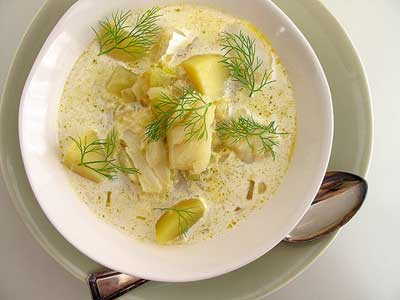 I can't think of anything more American than chowder. This seafood soup is synonymous with chilly days and large family gatherings. Even though we're almost into spring, the weather has continued to be cold and dreary here in the Northeast. I've been craving hot bowls of soothing soup. There are many different recipes for chowder, including the little-known Rhode Island-style made of clear broth. But the one I'm a fan of is creamy New England-style, which was probably the first recorded chowder recipe, dating back to the 18th century. It just so happens that I'm the outlier in a family of all Manhattan-style lovers. Still for me, the fish broth enriched with cream holds the most appeal. That richness is what makes this chowder so soul-satisfying.
I can't think of anything more American than chowder. This seafood soup is synonymous with chilly days and large family gatherings. Even though we're almost into spring, the weather has continued to be cold and dreary here in the Northeast. I've been craving hot bowls of soothing soup. There are many different recipes for chowder, including the little-known Rhode Island-style made of clear broth. But the one I'm a fan of is creamy New England-style, which was probably the first recorded chowder recipe, dating back to the 18th century. It just so happens that I'm the outlier in a family of all Manhattan-style lovers. Still for me, the fish broth enriched with cream holds the most appeal. That richness is what makes this chowder so soul-satisfying.
The recipe for chowder originally came from France ("chowder" comes from the word chaudière, meaning cauldron) and eventually made its way to England and over to the New World with the colonists. The recipe evolved according to the surroundings, availability of seafood, and the specific tastes of the region. Somewhere along the line certain recipes became more popular than others. Immigrants added their particular spin: the Portuguese added tomatoes to clear-broth chowder and invented what we know as Manhattan-style. That began the epic rivalry between New England- and Manhattan-style chowders, now typically made with clams. But the first chowders in America were made with fish.
Winter
Winter
Lentil Soup
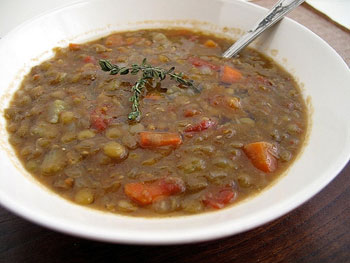 In many countries it's tradition to eat good-luck foods in the first few days of the new year or sometimes in the last few seconds of the old one. People in Spain stuff their mouths with grapes as the clock counts down the last twelve seconds. In the United States, Southerners eat collards and black-eyed peas because they symbolize money. My Hungarian heritage is not without its new year's food superstitions.
In many countries it's tradition to eat good-luck foods in the first few days of the new year or sometimes in the last few seconds of the old one. People in Spain stuff their mouths with grapes as the clock counts down the last twelve seconds. In the United States, Southerners eat collards and black-eyed peas because they symbolize money. My Hungarian heritage is not without its new year's food superstitions.
To celebrate, we eat pork and lentil soup. Supposedly because pigs root forward, they are a forward-looking bunch of animals. Chickens are not since they scratch backward. We eat lentil soup because the little lentils resemble coins. So the custom of eating good-luck foods is all to gain prosperity for the new year. Believe me I'd eat all these foods all the time if it meant prosperity for the entire year.
A Creamy Soup for a New (Healthy) Year
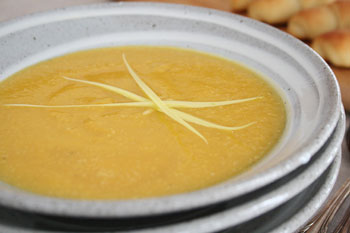 As the New Year begins, it only seems right to offer a recipe for a soup that is chock full of vegetables and even a little bit of fruit. The creamy soup will incorporate nicely into a regime of healthful menus.
As the New Year begins, it only seems right to offer a recipe for a soup that is chock full of vegetables and even a little bit of fruit. The creamy soup will incorporate nicely into a regime of healthful menus.
I’ve been making this soup for years. A long time ago, much longer than I’d like to admit, I joined a group of women once a month for a Sunday afternoon meal. We called it our Recipe Exchange Group. We would each prepare a part of the meal and bring along the recipe to share. Elsa, our friend from Argentina, brought this soup to one of those long-ago meals where we’d not only eat, but also chat about our kids, our husbands, and food. It was an appreciated outlet for all of us in this small group of moms who liked to cook.
If you have made a resolution to eat more fruits and vegetables each day, this soup will make it easy. There is a fair amount of chopping involved, but once that task has been accomplished, the soup will be ready to eat in no time.
A Winter Salad
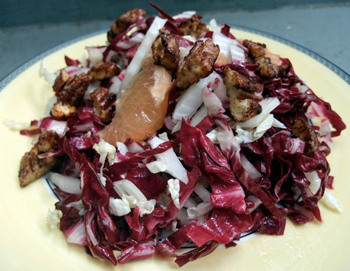 As part of my resolution to eat more salad, I am trying to buy ingredients that can be turned into a salad without too much fuss. You practically need to buy tender salad greens every day so I've been buying crunchy vegetables and hardier leafy greens instead. On my shopping lists these days are daikon radish, carrots, celery, fennel and red radishes. Shaved thin, they all are great salad fixings. I also buy avocados, and some citrus fruit to gussy up my salads.
As part of my resolution to eat more salad, I am trying to buy ingredients that can be turned into a salad without too much fuss. You practically need to buy tender salad greens every day so I've been buying crunchy vegetables and hardier leafy greens instead. On my shopping lists these days are daikon radish, carrots, celery, fennel and red radishes. Shaved thin, they all are great salad fixings. I also buy avocados, and some citrus fruit to gussy up my salads.
I made this particular salad one night when I wasn't hungry enough for dinner and I had very little in the house to cook anyway. I loved it so much that I keep going back to the store to buy the same ingredients so I can make it again! It's based on my very faulty recollection of the Grapefruit Jicama Salad from the Slanted Door.
A Winter Pick-Me-Up: Roasted Vegetable Salad
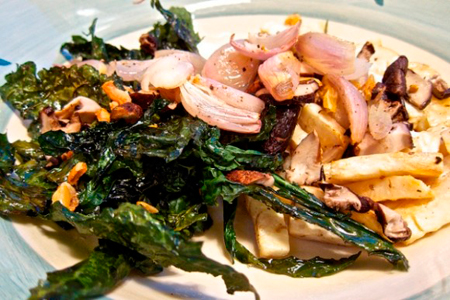 Now that the fall has given way to colder weather, enjoying winter’s chill outdoors requires a well-insulated coat and good gloves. Indoors, the kitchen fights back the cold with a hot oven and good food ready to eat. The best winter food comforts our spirits and nourishes our bodies. Nothing does that better than a roasted vegetable salad.
Now that the fall has given way to colder weather, enjoying winter’s chill outdoors requires a well-insulated coat and good gloves. Indoors, the kitchen fights back the cold with a hot oven and good food ready to eat. The best winter food comforts our spirits and nourishes our bodies. Nothing does that better than a roasted vegetable salad.
In summer, a ripe tomato salad mixed with peppery arugula leaves and bits of salty, creamy Bulgarian feta can be a meal in and of itself. When the weather cools and a weakening sun denies farmers the heat they need to grow nature’s leafy wonders, we still hunger for salads but now it’s time to look to hearty greens and root vegetables to satisfy that craving.
In winter, walking through the local supermarket’s fresh produce section, it’s easy to believe we live in a one-season world. Vegetables and fruit that require summer’s heat are stacked high in the bins. But one taste and it’s easy to tell, these delectables have been grown out of season or traveled long distances to reach our tables.
Root vegetables like celery root, beets, turnips and potatoes grow well in the colder months. When roasted, their starches convert into sugar, coaxing the best out of these subterranean gems.
More Articles ...
Welcome to the new One for the Table ...
Our Home Page will be different each time you arrive.
We're sure you'll find something to pique your interest...
